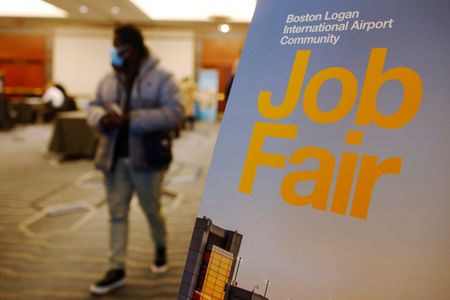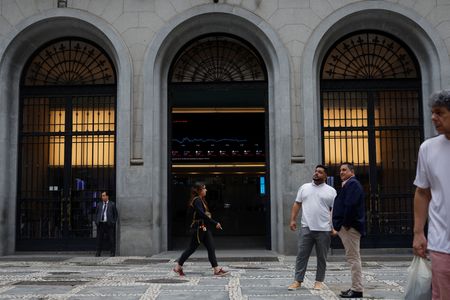By Ann Saphir and Dan Burns
(Reuters) -The number of Americans filing new applications for jobless benefits unexpectedly fell to a seven-week low last week, suggesting employers may be holding on to workers despite other indications of a cooling labor market and creating no urgency for the Federal Reserve to resume its interest rate cuts.
Initial claims for state unemployment benefits dropped for a fourth straight week in the week ending July 5, falling by 5,000 to a seasonally adjusted 227,000, the Labor Department said on Thursday.
Economists polled by Reuters had forecast 235,000 claims for the latest week. The data included last week’s July Fourth holiday and claims tend to be volatile around public holidays.
Seasonal factors also were at play.
Non-seasonally adjusted new claims rose by just over 10,000, led by increases in auto manufacturing states like Michigan, Ohio and Tennessee where plant retooling shutdowns are common at this time each year.
But those likely temporary layoffs were not as large as the nearly 15,000 predicted by the Labor Department’s seasonal factors model.
That dynamic will continue to affect the data for the next several weeks.
Seasonally adjusted new benefits claims, seen by economists as one of the most timely indicators of the health of the job market, crested in early June at their highest level since October but have fallen each week since.
“Private-sector businesses have done well to preserve margin by reducing labor costs via attrition, shorter hours and part-time employment … to mitigate slack, rather than mass layoffs,” Thomas Simons, chief U.S.
economist at Jefferies, said in a note. “We expect that this is mostly going to continue to be a theme going forward, but time may be running out on this strategy.”
LOW HIRING TREND
The trend evident in the claims data aligns with the view of economists and U.S.
central bankers, who generally see the labor market as solid, if weakening somewhat. Last week’s monthly jobs report was emblematic of that mixed assessment. The unemployment rate ticked down to 4.1% in June, though largely because the workforce shrank as the participation rate slid to a two-and-a-half-year low.
And while a greater-than-expected 147,000 new jobs were created, those positions were highly concentrated in just a few sectors.
Fed Chair Jerome Powell has noted that in the current low-hiring and low-firing environment, any increase in layoffs could rapidly push up the unemployment rate.
That has not happened so far, though nearly 100 U.S.
companies have announced layoffs this month, including Microsoft and Intel. Economists say President Donald Trump’s unsettled tariff policy is making it difficult for businesses to plan ahead. Trump this week has peppered more than 20 trading partners with letters informing them that tariff rates on their goods would climb sharply from the current 10% baseline, announced a 50% levy on copper imports and said more duties would be unveiled soon for pharmaceuticals and semiconductors.
In the face of broad uncertainty around economic policy, hiring has grown more lackluster in recent months, making it harder for people out of work to find jobs.
The 12-month average of jobs created is roughly 150,000, around the lowest of the post-pandemic period and about 35,000 below the average in the years just prior to the health crisis.
Last week’s jobs report showed the median duration of unemployment rose in June to 10.1 weeks from 9.5 weeks in May, suggesting those who lose a job are taking longer to find a new one.
That trend was backed up by an uptick in the number of people receiving unemployment benefits after an initial week of aid, a proxy for hiring. That figure increased 10,000 to a seasonally adjusted 1.965 million during the week ending June 28, the highest level since November 2021, the latest claims report showed.
“Despite some seasonal noise, the claims data are telling a familiar story about the labor market, namely that it continues to be characterized by a low pace of layoffs and a low rate of hiring, making it difficult for those who are unemployed to find new jobs,” said Nancy Vanden Houten, lead U.S.
economist at Oxford Economics. “We expect some pickup in layoffs as the economy slows and the full weight of tariffs is felt, but look for only a modest uptick in the unemployment rate.”
The Fed last month left its policy rate in the 4.25%-4.50% range where it has been since December as central bankers wait to see if tariffs push up inflation before moving to lower rates.
Rate futures markets are positioned for reductions beginning again in September, with contract pricing leaning toward two quarter-percentage-point reductions by the end of this year.
(Reporting by Ann Saphir and Dan Burns; Editing by Chizu Nomiyama and Paul Simao)











